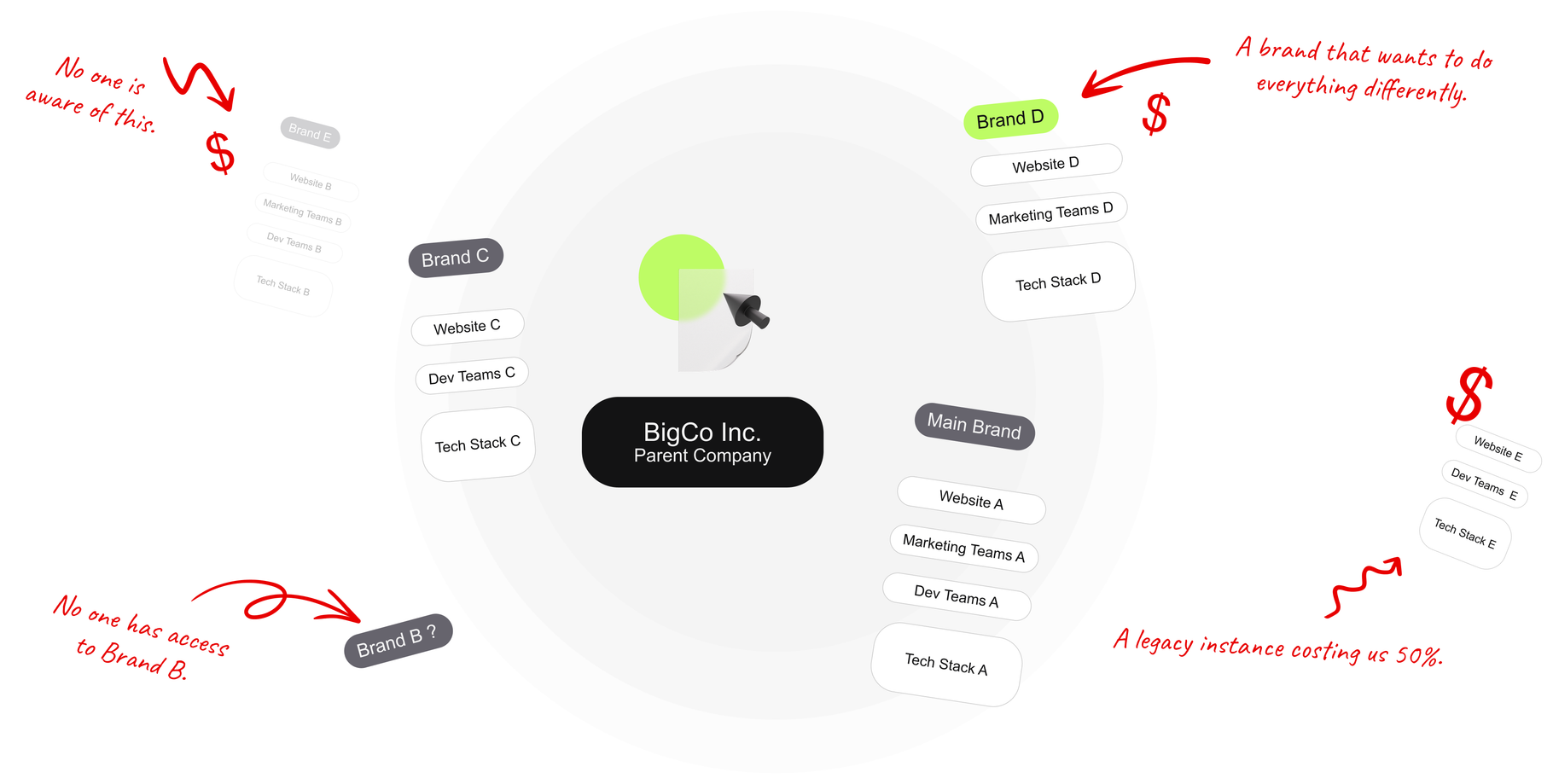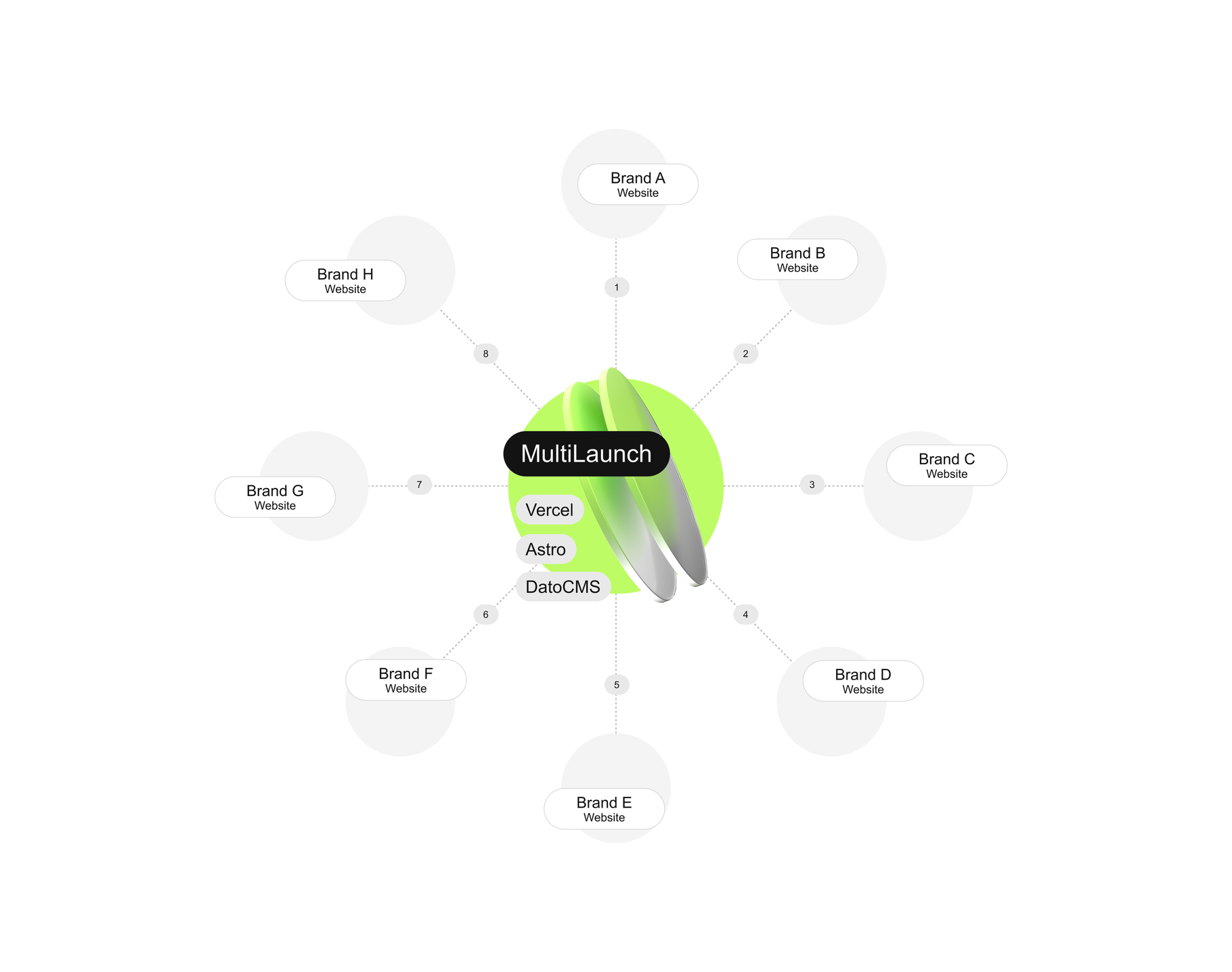July 21, 2025
3 min
One Stack, Faster Launches, Lower Costs: How Multi-Brand Companies Win Online?
 MS
MS TK
TKMojtaba and Thom
In this post, we introduce MultiLaunch — a solution architecture that helps multi-brand companies manage all their websites with one stack, faster launches, and lower costs.
Managing websites across multiple brands and regions often turns into a mess. Outdated systems. Disconnected teams. Inconsistent design. Launches slow down. Brands suffer.
At Bejamas, we believe there’s a smarter way to grow. One that keeps things fast, clean, and scalable — even as your brand portfolio expands. In this post, we’ll show you how.
Death by a Thousand Microsites
Take a large pharma company with 50+ brands across dozens of countries — from skincare to supplements to OTC meds.
On paper, the brand architecture looks great. Parent brands, sub-brands, local sites. But online?
It’s chaos:
- Designs are inconsistent.
- Some websites haven’t been updated in years.
- Each brand uses a different CMS, tech stack, and hosting provider.
- Some were built internally, others outsourced to random agencies.

Every brand runs on its own island — different tools, different teams, no shared foundation. It’s slow, inconsistent, and impossible to scale.
And the result is always the same:
- Slow, painful site launches — taking months to go live.
- Design inconsistency — each site looks like it came from a different company.
- Siloed tools and teams — Different CMS platforms, different devs, different workflows
- High maintenance cost – More infra, more vendor lock-in, more headaches
The worst part? The brand suffers. To users, these websites feel neglected, outdated, and disconnected.
We call it “death by a thousand microsites.” It’s not just about messy websites — it’s about how fast your business can move.
Most companies don’t realize it, but they’re growing faster than their tech stack can handle.
How We Fix It: Introducing MultiLaunch
We’ve worked with global brands like Costa, Hanse, and Danone (which owns brands like Alpro), helping them bring order to the chaos. What they needed wasn’t just “more websites.” They needed a way to scale without rebuilding the foundation every time.
That’s what MultiLaunch delivers.
It's an architecture built for companies running multiple brands, in multiple markets, using multiple languages — without multiple headaches.
Join Newsletter
Don't miss new posts about MultiLaunch.
How We Structure It – No Guesswork Needed:
- One frontend framework (Astro) for performance and design flexibility
- One headless CMS (DatoCMS) structured for multi-brand, multi-region content
- One hosting platform (Vercel) that scales automatically
- One monorepo for all brands and sites
- One dev team managing the whole thing

A unified setup where every brand and region runs on the same scalable system.
Of course, the stack can vary depending on your needs — Astro, DatoCMS, and Vercel are just how we chose to demonstrate the concept. The "Stack Flexibility" is high - you can change and replace each part of the stack without huge migration, so for example if there is a better competitor for Vercel, you can switch without switching everything else.
In this unified setup, adding a new brand website or regional variant becomes refreshingly simple. No need to start a whole new project, spin up new hosting, or hire another agency. Everything stays connected, structured, and scalable – without becoming a technical nightmare.
BTW
Our friends at DatoCMS loved MultiLaunch and shared their own in-depth posts about it. Be sure to check them out:
- On building Astro themes for multi-brand websites
- Building MultiLaunch (Part 1): Structuring DatoCMS Like a System
- Building MultiLaunch (Part 2): The CMS Experience for Editors
- Building MultiLaunch (Part 3): The Repo and the DX
See It In Action: Launching a New Brand in Minutes
Once your MultiLaunch architecture is in place, adding a new website for a sub-brand takes just minutes. Here's the entire process:
- Create a new project entry in DatoCMS
- Add brand assets and content
- Set localization
- Spin up a new Vercel project
- Deploy — and your new site is live!
That’s it. No tech delays. No duplicated work. No guesswork.
Tired of juggling messy brand sites?
We can help you simplify it all with MultiLaunch.
What You Get With MultiLaunch
MultiLaunch doesn’t hide the complexity of multi-brand website ecosystems. It organizes it.
vs Old Way | vs MultiLaunch Way | |
|---|---|---|
CMS | Every brand uses a different CMS | One headless CMS structured for multi-brand use |
Hosting | Separate hosting per brand | One hosting platform that scales automatically |
Dev Teams | Different vendors and tech stacks | One dev team, one stack |
Vendor Lock-in | High | Low (swap tools anytime) |
Launch Speed | Months per site | Minutes per site |
Design Consistency | Every site looks different | Unified system across brands |
Design Flexibility | High | Mid to High* |
Maintenance Cost | High (multiple platforms) | Low (one stack to maintain) |
Governance | Hard to manage | Centralized access and control |
Localization | Manual, repeated work | Structured and flexible |
* The bonus for MultiLaunch is that each change requested and developed for one brand can be introduced to other brands too!
Using this architecture, your marketing team moves faster without constantly waiting on developers. Your budget stretches further because you're not rebuilding the same foundation repeatedly. Updates can target one brand, one region, or everything at once, giving you unprecedented control.
And all of this comes with reduced infrastructure costs, better permission management, lower technical debt, and easier governance – exactly how enterprise websites should work.
MultiLaunch means you stop rebuilding and start scaling with structure that actually holds up.
Ready to Clean Up the Chaos?
That pharmaceutical company with 50 scattered websites? They could unify everything under one system — with faster launches, tighter governance, and better brand control.
If your current setup is slowing you down, let’s talk. We’ll show you exactly how this architecture can help you launch faster, stay consistent, and future-proof your websites. Get in touch!
Authors
 MS
MSCrafting content on modern web technologies.
 TK
TKCo-founder of Bejamas. Focuses on helping people create faster and better websites and apps. Never bet against the Web.



